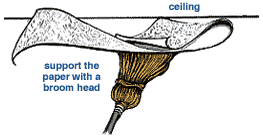GOING GREEN

BAMBOO: A grass that grows extremely quickly, bamboo can be harvested in just 3 to 5 years compared with many species of trees, which can take 10 to 20 years or more to mature. Bamboo can be grown without pesticides and fertilizers, and it never requires replanting because of its extensive root system.Organic materials are literally bringing nature indoors. Exposed wood grain in blinds and natural woven shades are becoming popular choices. Wood is making a comeback in decorative hardware, while bamboo, birch and maple are the materials of choice for the newest finials and pulls.
One of the most popular window treatments are the natural woven shades in bamboo and matchstick. These woven shades come in different colors of wood, and some include grassy woven accents.Shades and blinds have always been about keeping light out, but now they can also save you money on your heating bills. Honeycomb shades, the third most popular window treatment creates a detour for the wind or the cold to not go into your home.
Linen: Linen is best suited for formal living rooms or adult areas because it soils and wrinkles easily. And, it won’t withstand heavy wear. However, linen does resist pilling and fading. Soiled linen upholstery must be professionally cleaned to avoid shrinkage.
Leather: This tough material can be gently vacuumed, damp-wiped as needed, and cleaned with leather conditioner or saddle soap.
Cotton: Cotton fiber can be USDA certified organic, but processing the fiber into a textile is not covered. Select organic cotton products that have been dyed with “low-impact fiber reactive dyes” and finished without formaldehyde. Product labels should mention voluntary third-party standards or certifications such as Eko (certified by Skal), Oeko-Tex, or the Global Organic Textile Standards. These are meant to ensure that production and/or processing is eco-friendly.
Also, find textiles that can be machine washed so you can avoid dry-cleaning chemicals. If an item is a blend, check whether it’s blended with another sustainable fiber like hemp or linen, rather than conventional cotton or a synthetic fiber.
This natural fiber provides good resistance to wear, fading, and pilling. It is less resistant to soil, wrinkling, and fire. Surface treatments and blending with other fibers often atone for these weaknesses. Durability and use depend on the weave and finish. Damask weaves are formal; canvas (duck and sailcloth) is more casual and more durable.
Wool: Sturdy and durable, wool and wool blends offer good resistance to pilling, fading, wrinkling, and soil. Generally, wool is blended with a synthetic fiber to make it easier to clean and to reduce the possibility of felting the fibers (causing them to bond together until they resemble felt). Blends can be spot-cleaned when necessary.
Cotton Blend: Depending on the weave, cotton blends can be sturdy, family-friendly fabrics. A stain-resistant finish should be applied for everyday use.
Vinyl: Easy-care and less expensive than leather, vinyls are ideal for busy family living and dining rooms. Durability depends on quality.
Silk: This delicate fabric is only suitable for adult areas, such as formal living rooms. It must be professionally cleaned if soiled.
Economically and environmentally safe treatments now offered as affordable options for window treatments. Green design is becoming apopular trend for those looking to combat allergies as well as those looking for heat- or cold-repellant window panels.
For larger, sliding glass windows, the solar panels will reduce glare, UV penetration and heat transfer.
Performance fabrics have also gone “green,” with anti-microbial, anti-fungal traits woven into the yarn or offered as a topical spray. Stain-resistant and mildew- and mold-resistant fabrics are also popular picks for allergy sufferers. Even the environmentally conscious will feel right at home with non-toxic dyes on fabrics.
Look for products that incorporate recycled content (since it reduces the use of raw materials), renewable fibers like organic cotton and hemp that can be grown without most pesticides, and wood that comes from forests that are certified.
